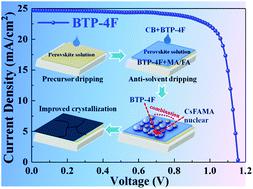当前位置:
X-MOL 学术
›
Nanoscale Horiz.
›
论文详情
Our official English website, www.x-mol.net, welcomes your
feedback! (Note: you will need to create a separate account there.)
Interface and grain boundary passivation for efficient and stable perovskite solar cells: the effect of terminal groups in hydrophobic fused benzothiadiazole-based organic semiconductors
Nanoscale Horizons ( IF 8.0 ) Pub Date : 2020-09-21 , DOI: 10.1039/d0nh00374c Yanbo Gao 1, 2, 3, 4, 5 , Yanjie Wu 1, 2, 3, 4, 5 , Yue Liu 1, 2, 3, 4, 5 , Min Lu 1, 2, 3, 4, 5 , Lili Yang 5, 6, 7, 8 , Yinghui Wang 3, 9, 10, 11, 12 , William W. Yu 1, 2, 3, 4, 5 , Xue Bai 1, 2, 3, 4, 5 , Yu Zhang 1, 2, 3, 4, 5 , Qilin Dai 13, 14, 15, 16
Nanoscale Horizons ( IF 8.0 ) Pub Date : 2020-09-21 , DOI: 10.1039/d0nh00374c Yanbo Gao 1, 2, 3, 4, 5 , Yanjie Wu 1, 2, 3, 4, 5 , Yue Liu 1, 2, 3, 4, 5 , Min Lu 1, 2, 3, 4, 5 , Lili Yang 5, 6, 7, 8 , Yinghui Wang 3, 9, 10, 11, 12 , William W. Yu 1, 2, 3, 4, 5 , Xue Bai 1, 2, 3, 4, 5 , Yu Zhang 1, 2, 3, 4, 5 , Qilin Dai 13, 14, 15, 16
Affiliation

|
The defects at the interface and grain boundaries (GBs) of perovskite films limit the performance of perovskite solar cells (PSCs) seriously. Herein, organic semiconductors with different terminal groups including a ladder-type electron-deficient-core-based fused structure (DAD) fused core with 2-(3-oxo-2,3-dihydro-1H-inden-1 ylidene)malononitrile (BTP-4H), DAD with 2-(5,6-dichloro-3-oxo-2,3-dihydro-1H-inden-1 ylidene)malononitrile (BTP-4Cl), and DAD with 2-(5,6-difluoro-3-oxo-2,3-dihydro-1H-inden-1 ylidene)malononitrile (BTP-4F) are introduced into perovskite films to study the effects of the terminal groups on the PSC performance. A physical model is proposed to understand the effects of the terminal groups on the perovskite growth and energy level alignment of devices. Compared with BTP-4H and BTP-4Cl, BTP-4F can more effectively delay the crystallization rate and increase the crystal sizes due to hydrogen bonding of F and FA. BTP-4F can also provide more efficient charge transport channels due to the optimal energy level alignment. Most importantly, BTP-4F can promote charge transport from the perovskite film to spiro-OMeTAD and to SnO2, thus realizing simultaneous up-bottom passivation of perovskite films. Finally, the BTP-4F passivated PSCs exhibit a remarkable PCE of 22.16%, and the device can maintain ∼86% of the initial PCE after 5000 h. Therefore, this work presents significant potential of organic semiconductors in PSCs toward high efficiency and high stability due to the terminal groups.
中文翻译:

高效稳定的钙钛矿太阳能电池的界面和晶界钝化:疏水基苯并噻二唑基有机半导体中端基的影响
钙钛矿薄膜的界面和晶界(GBs)上的缺陷严重限制了钙钛矿太阳能电池(PSC)的性能。本文中,具有不同端基的有机半导体包括具有2-(3-氧代-2,3-二氢-1 H-茚满-1亚基)丙二腈的梯型基于电子缺陷核的稠合结构(DAD)稠合核(BTP-4H),带有2-(5,6-dichloro-3-oxo-2,3-dihydro-1 H -inden-1 ylydenne ylidene)丙二腈(BTP-4Cl)的DAD和带有2-(5, 6-二氟-3-氧代-2,3-二氢-1 H钙钛矿薄膜中引入了1-茚基亚丙基)丙二腈(BTP-4F),以研究端基对PSC性能的影响。提出了一个物理模型来理解端基对钙钛矿生长和器件能级对准的影响。与BTP-4H和BTP-4Cl相比,由于F和FA的氢键结合,BTP-4F可以更有效地延迟结晶速率并增加晶体尺寸。由于最佳的能级对齐,BTP-4F还可以提供更有效的电荷传输通道。最重要的是,BTP-4F可以促进钙钛矿膜中电荷向螺-OMeTAD以及SnO 2的电荷传输。,从而实现了钙钛矿薄膜同时自上而下的钝化。最后,BTP-4F钝化的PSC表现出显着的PCE达22.16%,并且在5000小时后,该器件可以维持约86%的初始PCE。因此,由于末端基团的缘故,这项工作为PSC中的有机半导体带来了巨大的潜力,朝着高效率和高稳定性的方向发展。
更新日期:2020-11-03
中文翻译:

高效稳定的钙钛矿太阳能电池的界面和晶界钝化:疏水基苯并噻二唑基有机半导体中端基的影响
钙钛矿薄膜的界面和晶界(GBs)上的缺陷严重限制了钙钛矿太阳能电池(PSC)的性能。本文中,具有不同端基的有机半导体包括具有2-(3-氧代-2,3-二氢-1 H-茚满-1亚基)丙二腈的梯型基于电子缺陷核的稠合结构(DAD)稠合核(BTP-4H),带有2-(5,6-dichloro-3-oxo-2,3-dihydro-1 H -inden-1 ylydenne ylidene)丙二腈(BTP-4Cl)的DAD和带有2-(5, 6-二氟-3-氧代-2,3-二氢-1 H钙钛矿薄膜中引入了1-茚基亚丙基)丙二腈(BTP-4F),以研究端基对PSC性能的影响。提出了一个物理模型来理解端基对钙钛矿生长和器件能级对准的影响。与BTP-4H和BTP-4Cl相比,由于F和FA的氢键结合,BTP-4F可以更有效地延迟结晶速率并增加晶体尺寸。由于最佳的能级对齐,BTP-4F还可以提供更有效的电荷传输通道。最重要的是,BTP-4F可以促进钙钛矿膜中电荷向螺-OMeTAD以及SnO 2的电荷传输。,从而实现了钙钛矿薄膜同时自上而下的钝化。最后,BTP-4F钝化的PSC表现出显着的PCE达22.16%,并且在5000小时后,该器件可以维持约86%的初始PCE。因此,由于末端基团的缘故,这项工作为PSC中的有机半导体带来了巨大的潜力,朝着高效率和高稳定性的方向发展。











































 京公网安备 11010802027423号
京公网安备 11010802027423号